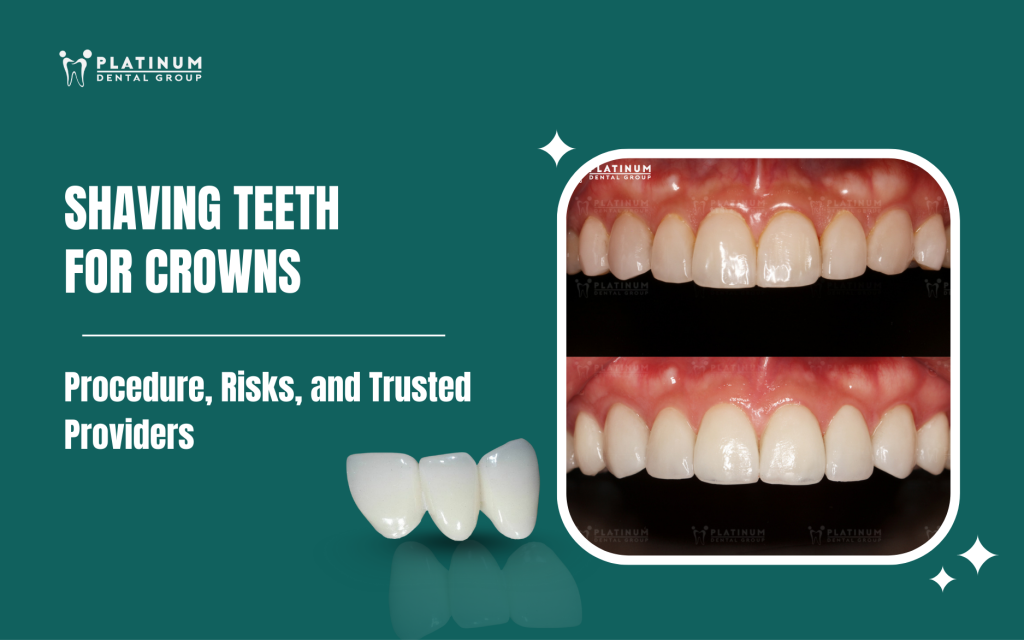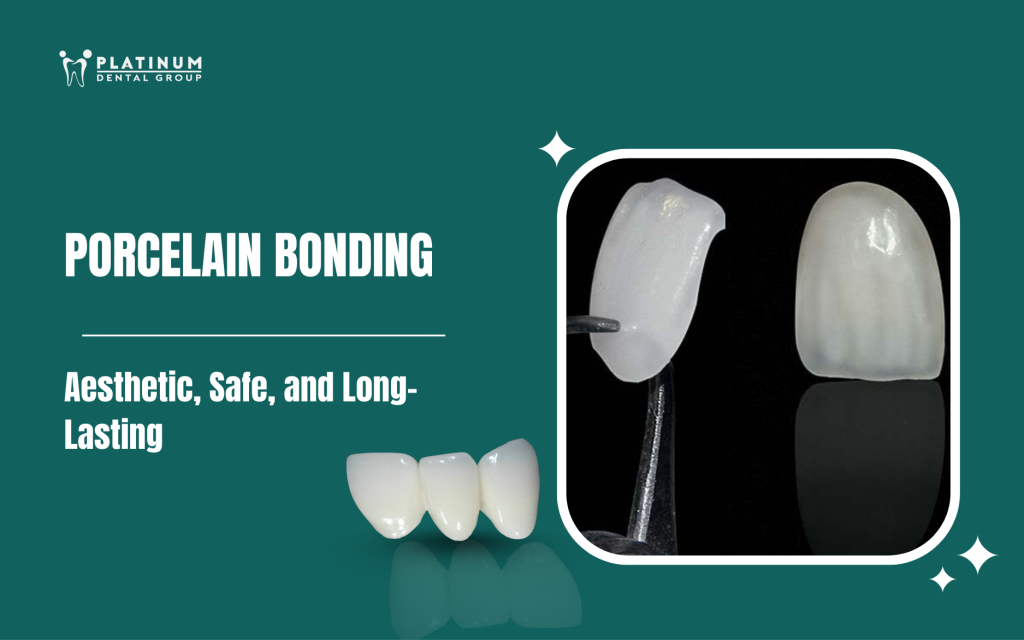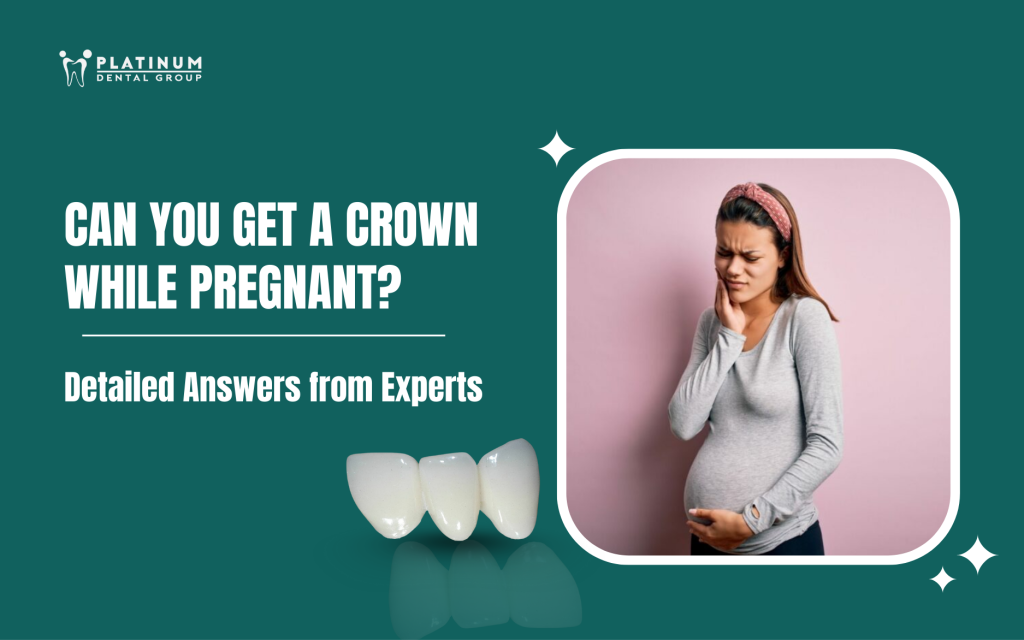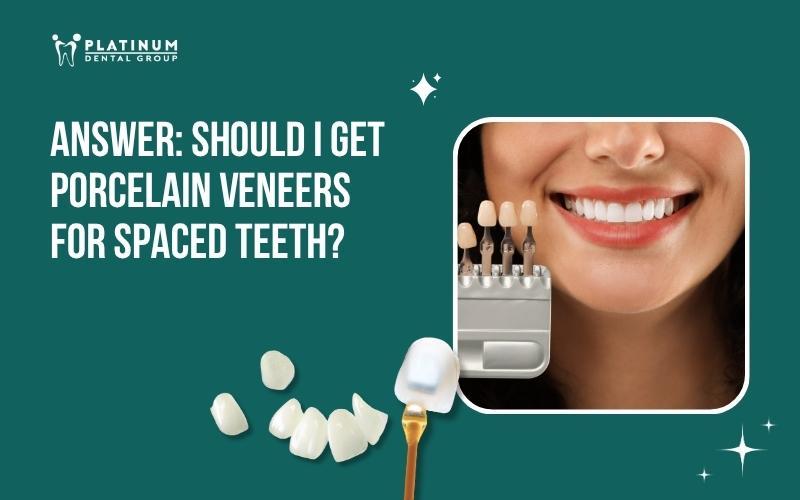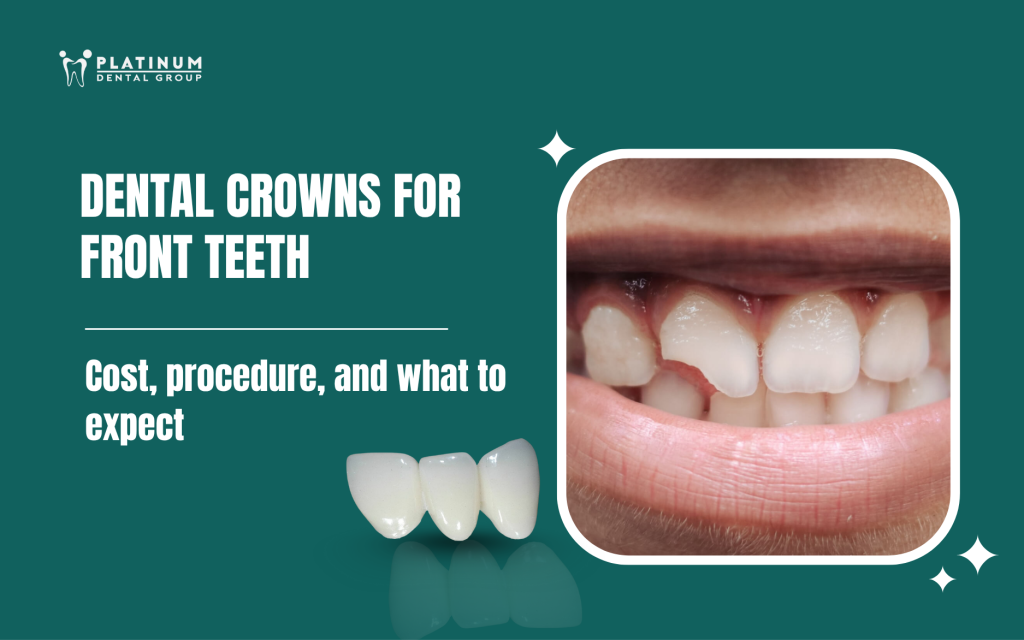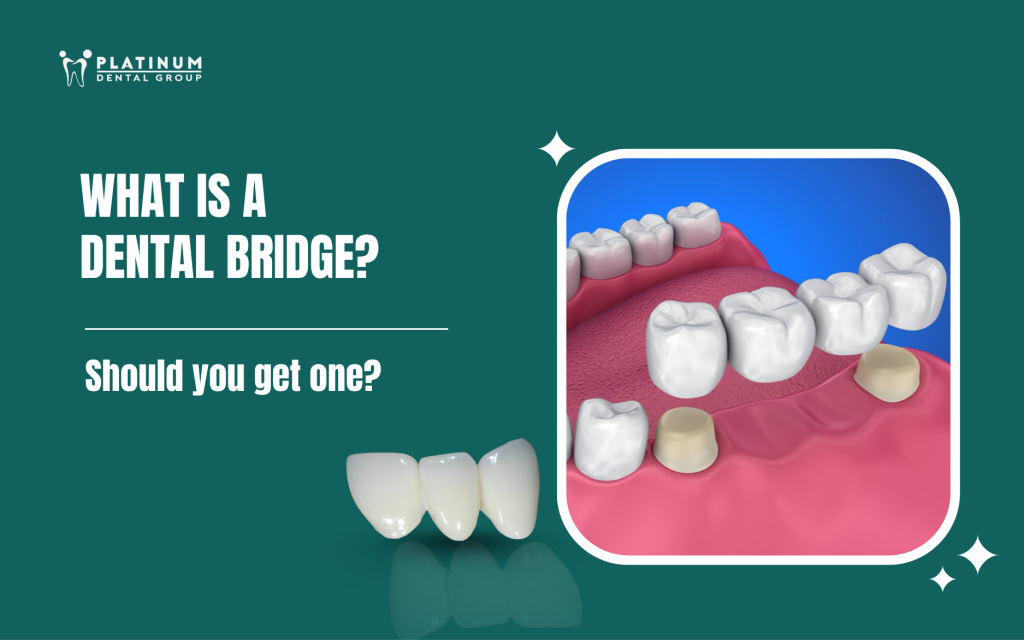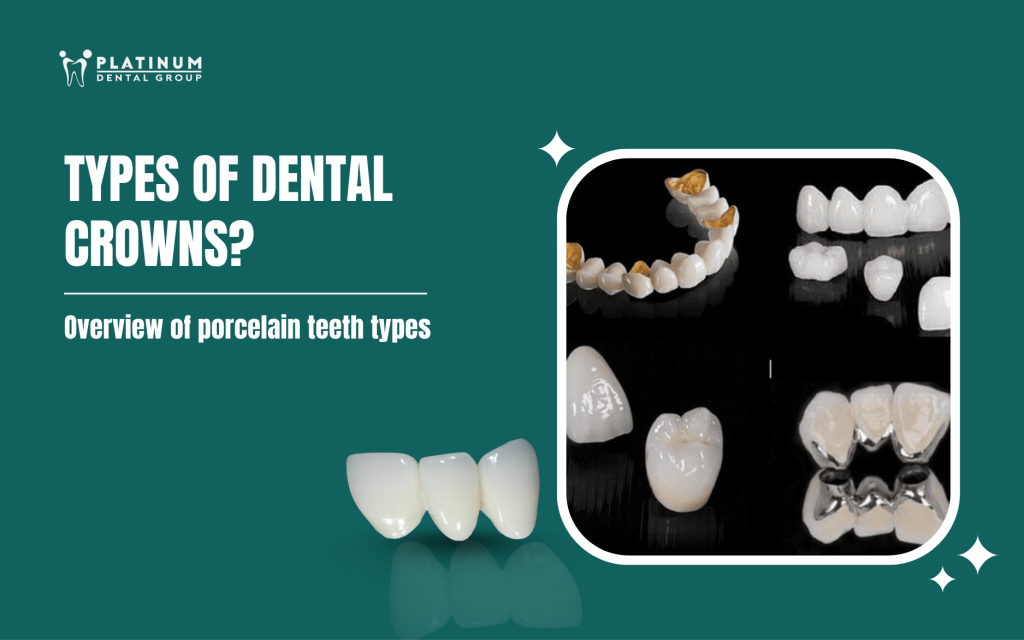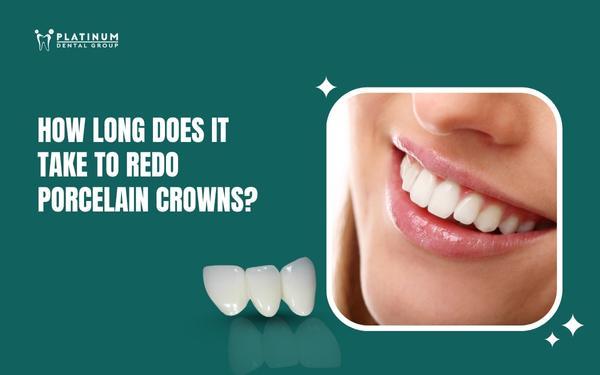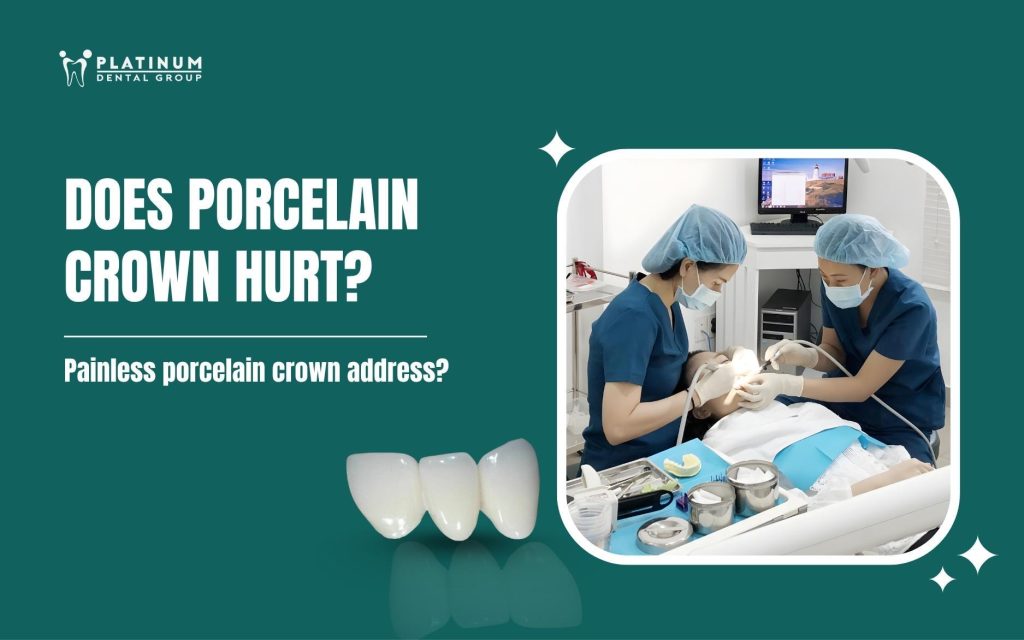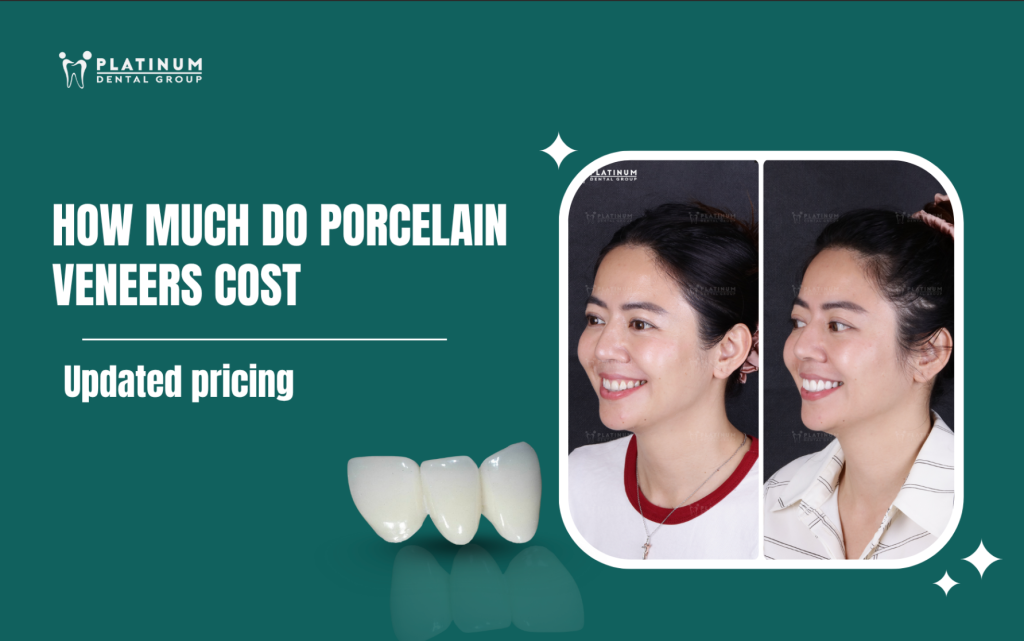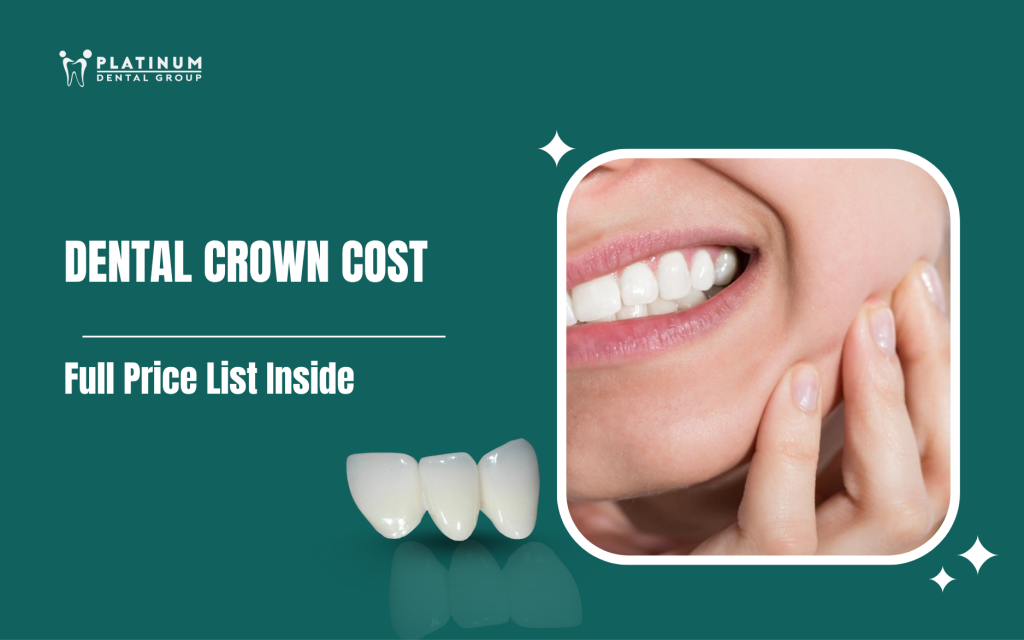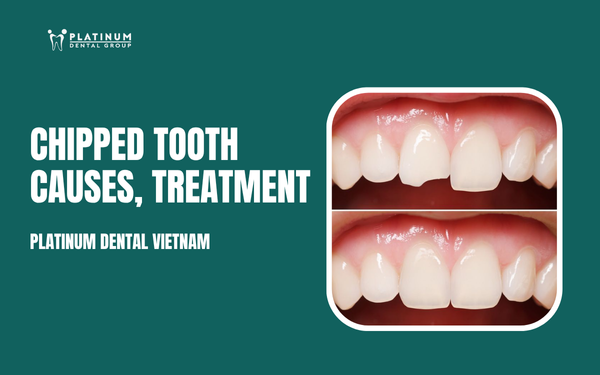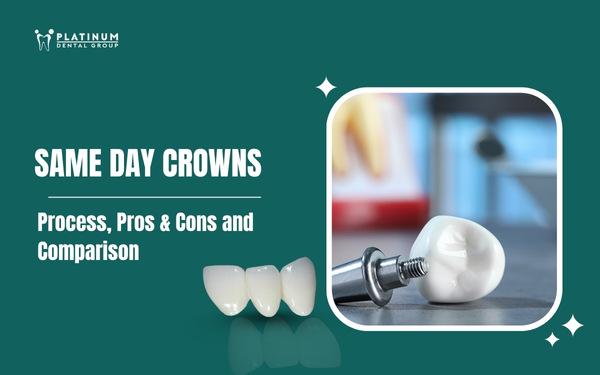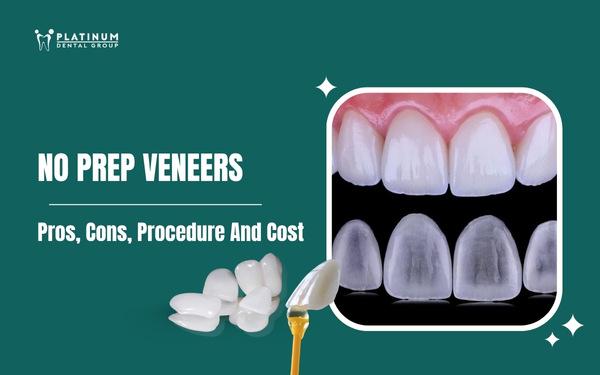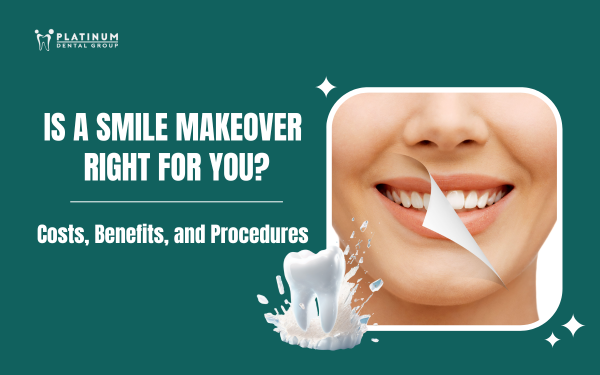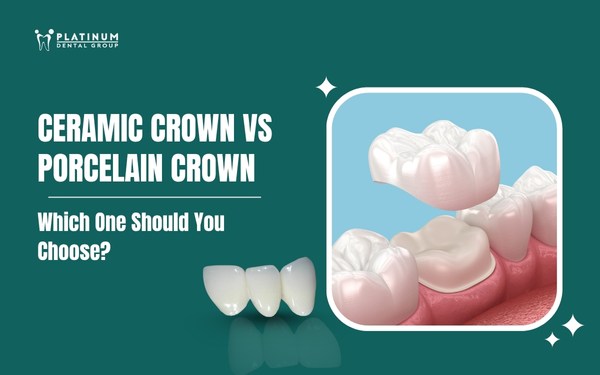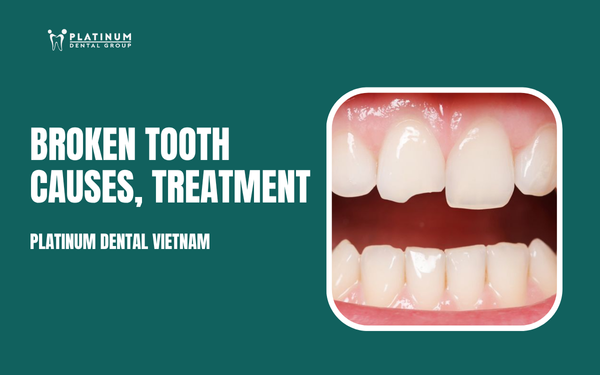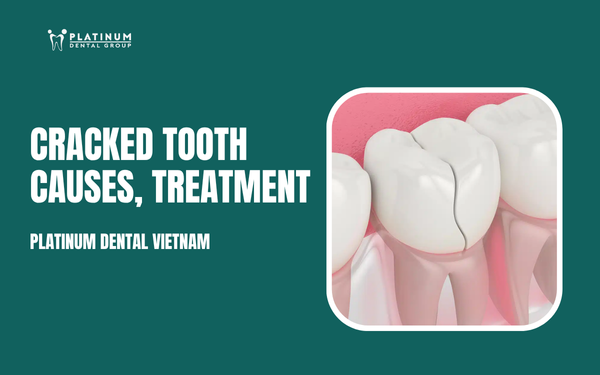Nowadays, the need for porcelain teeth is becoming more and more popular as many people want to have bright, even, beautiful teeth and improve their chewing ability. However, the most important thing in the porcelain teeth process is not only the aesthetic factor but also the correct indication, correct oral condition and compliance with safety procedures. If the porcelain teeth procedure is performed hastily or incorrectly, real teeth can be affected, causing many complications later.
At Platinum Dental Group, we apply a standard, safe, and effective porcelain teeth procedure with a thorough examination, modern technology, and a team of highly specialized doctors. The following article will help you understand clearly: when to get porcelain teeth, the popular methods today, as well as the entire procedure is performed safely at Platinum Dental Group. This will be the basis for you to confidently choose the right restoration solution, both durable and natural for your smile.
Nội dung bài viết
- 1 When should I get porcelain teeth?
- 2 Current methods of making porcelain teeth
- 3 Porcelain teeth making process at Platinum Dental Group
- 3.1 General examination, assessment of dental condition
- 3.2 X-ray to assess the condition of the dental pulp
- 3.3 Perform root canal treatment (if necessary for porcelain crowns)
- 3.4 3D scan of teeth impression, prepare temporary teeth
- 3.5 Grind teeth, attach temporary teeth, and choose color
- 3.6 Try on porcelain teeth, discuss shape, color, and make adjustments if necessary
- 3.7 Fixed and adjusted joints
- 3.8 Re-examination
- 4 Why is it necessary to follow the porcelain teeth procedure?
- 5 Platinum Dental Group – A reputable porcelain teeth address in Ho Chi Minh City
- 6 FAQ
When should I get porcelain teeth?
Porcelain teeth are a modern method of tooth restoration, providing aesthetic and chewing function. However, the most important thing when deciding to have porcelain teeth is to have the right indication and be suitable for the specific oral condition. Especially with porcelain crowns, because it requires grinding a lot of tooth tissue, this is considered the last solution, only applied when other options to preserve real teeth are no longer effective.
Slightly discolored teeth, chipped bite surface, small gaps, uneven tooth shape
In cases where teeth are only slightly discolored, have small chips on the biting surface, have small gaps or are not evenly shaped, customers can choose porcelain veneers. This is a minimally invasive method, with almost no grinding of the teeth, helping to preserve the real teeth to the maximum. Thin porcelain veneers are individually crafted for each tooth, improving both color and overcoming physical defects, bringing a bright and natural smile.
The teeth are too stained
In cases of severe tooth discoloration due to tetracycline, fluoride or poor quality enamel, whitening or veneers are often ineffective. In this case, the dentist will prescribe a porcelain crown to cover the entire tooth, helping to improve the color and provide long-term aesthetics.
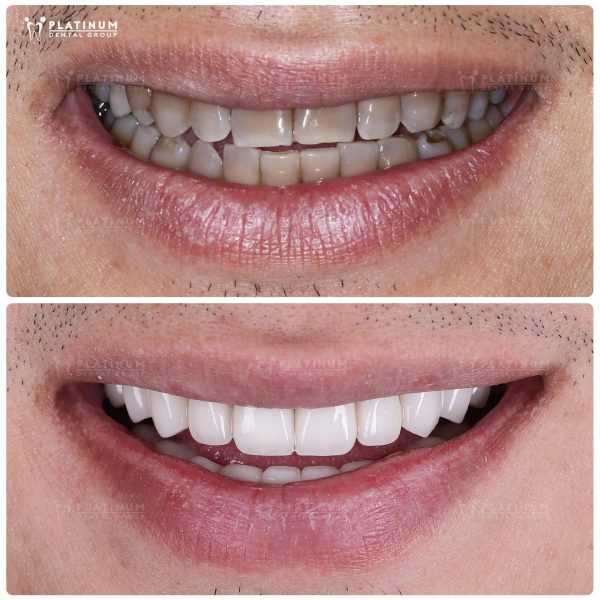
Broken or chipped teeth
If a tooth is fractured or extensively chipped, where composite bonding cannot guarantee durability, a dental crown is the appropriate choice. This method helps to protect the remaining natural tooth structure and root, restores chewing function, and minimizes the risk of further fracture.
Teeth that have dead pulp or need root canal treatment
After root canal treatment, teeth are often brittle, weak and prone to fracture. In this case, porcelain crowns act as a “shield”, protecting the tooth structure, while restoring both function and aesthetics. This is also the most common indication for porcelain crowns in dental treatment.
Teeth are worn out a lot
Habits such as teeth grinding, incorrect brushing techniques, or consuming highly acidic foods can lead to severe enamel erosion. When the tooth surface is worn down, it not only compromises aesthetics but also reduces chewing function and causes sensitivity. In these cases, a dental crown procedure will be indicated to protect the tooth and prevent the progression of further damage.
Uneven teeth (slight misalignment)
In some cases of minor misaligned or slightly crooked teeth without significant malocclusion (such as overbite, underbite, or crossbite), the dentist may indicate dental crowns/veneers to improve the shape and overall uniformity of the smile. However, if the misalignment is severe or if there is any malocclusion, orthodontics (braces/aligners) remains the more appropriate and safer method of correction.

Many people often assume that if their teeth are discolored, slightly crooked, or simply unattractive, they should immediately opt for dental crowns to achieve rapid aesthetic improvement. This, however, is a common misconception. In reality, not every case warrants tooth reduction (mài răng) for crowning, as excessive invasion can weaken the natural tooth, potentially leading to complications later on.
In many situations, less invasive methods such as professional whitening, cosmetic bonding, or veneers would be the safer and more appropriate choice. Therefore, the most crucial step before deciding on any dental restoration is receiving a comprehensive examination and the correct indication from a dentist based on your specific oral condition.
We invite you to learn more about the standardized dental procedure for Implant Placement at Platinum Dental.
Current methods of making porcelain teeth
Porcelain dental restoration does not have just one form but includes many different methods, depending on the condition of the teeth and the aesthetic needs of each person. At Platinum Dental Group, the doctor will advise and choose the most suitable solution after a thorough examination.
Inlay, onlay, overlay
Inlays, Onlays, and Overlays are types of indirect restorations (phục hình bán phần), often utilized when a tooth has suffered decay or fracture in only a portion of the tooth, but still retains healthy remaining tooth structure. Unlike traditional dental fillings, the porcelain Inlay/Onlay/Overlay is custom-fabricated in a dental lab and then bonded precisely into the defective area.
This method ensures high accuracy, natural aesthetics, and exceptional durability. It is the ideal approach for maximizing tooth preservation while effectively restoring chewing function.
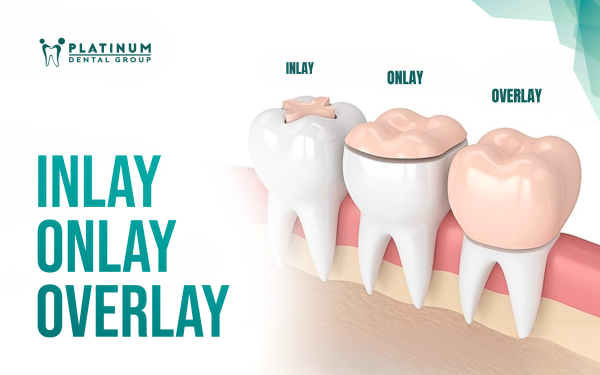
Porcelain veneer
A dental veneer is an ultra-thin porcelain layer (approximately 0.3−0.5mm) bonded to the outer surface of the tooth. It is ideal for cases involving minor tooth discoloration, small gaps (diastema), minimal chipping, or slight shape irregularities. The biggest advantage of veneers is that they require minimal tooth reduction—and in some cases, no reduction at all—thus allowing for maximum preservation of the natural tooth structure. This method delivers a high aesthetic outcome, ensuring a bright and natural-looking smile without significantly altering the original tooth structure.

Porcelain crown
A dental crown is a type of restoration that completely covers the entire tooth structure. It is typically indicated for cases involving non-vital (dead) teeth, extensive fractures, severe wear, or significant discoloration that cannot be rectified with veneers. Because it requires substantial tooth reduction, the dental crown is considered a last resort, to be applied only when other tooth preservation methods are no longer effective. The advantages of crowns are their ability to restore both aesthetics and chewing function, while simultaneously protecting the remaining natural tooth structure from further breakage.
Porcelain dental bridge
A dental bridge is utilized to replace missing teeth by reducing the adjacent natural teeth to serve as anchor abutments for the prosthetic tooth in the middle. This method restores chewing function and aesthetics in a short period, and the cost is often lower than that of dental implants.
However, the primary drawback of a dental bridge is the necessity of preparing the neighboring natural teeth, which can weaken the teeth and does not prevent long-term jawbone atrophy (tiêu xương hàm). Therefore, this is considered a temporary solution in some specific cases, and the dentist will carefully consider all factors before recommending it.
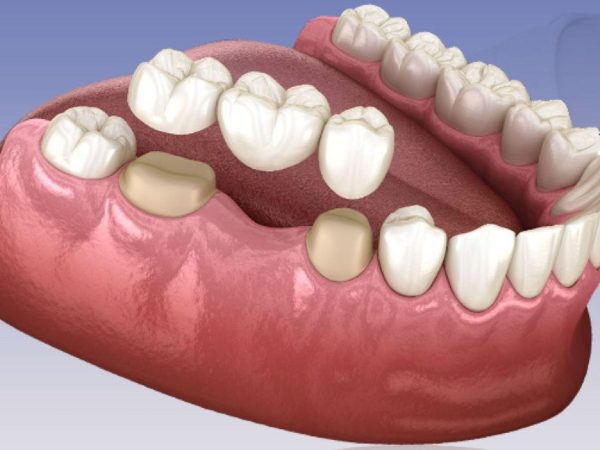
Every dental restoration technique has its own unique advantages and specific limitations. The correct technical choice must be based on the patient’s actual oral condition, their aesthetic goals, and the indication provided by a specialized dentist.
Porcelain teeth making process at Platinum Dental Group
To guarantee a natural aesthetic outcome, safety, and long-term durability, Platinum Dental Group implements a standardized dental veneer/crown procedure with clear, closed-loop steps. Each stage is performed by a team of highly specialized doctors, utilizing modern technology, aiming to provide clients with a comfortable experience and optimal restorative efficiency.
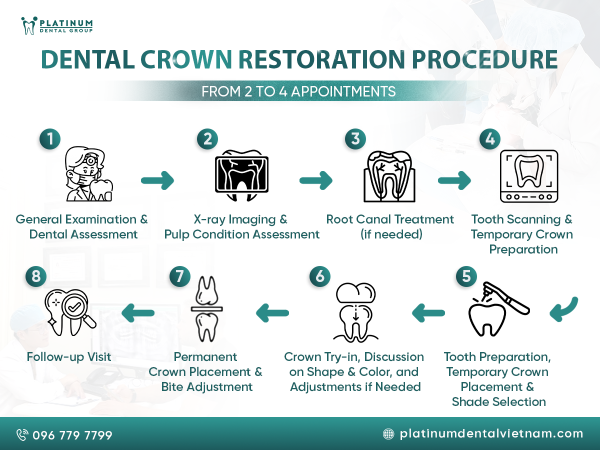

General examination, assessment of dental condition
The dentist will thoroughly examine the patient’s oral condition, checking the health of the gums, bite alignment, and any related pathologies. This is a critical step to evaluate whether the client meets the necessary criteria for the dental veneer/crown procedure or if prior treatment is required.
X-ray to assess the condition of the dental pulp
The client will undergo panoramic X-rays or diagnostic imaging to allow the doctor to precisely evaluate the tooth structure, pulp, and jawbone. These diagnostic results ensure accurate indication, preventing any potential underlying issues from being overlooked.

Perform root canal treatment (if necessary for porcelain crowns)
For teeth with pulp damage or those requiring root canal therapy, the dentist will proceed with thorough endodontic treatment before placing the dental crown. This essential step eliminates infection, ensuring the tooth is sound and durable after the final restoration.
3D scan of teeth impression, prepare temporary teeth
Platinum Dental Group utilizes advanced 3D scanning technology to capture digital dental impressions. Compared to traditional impression techniques, 3D scanning offers superior accuracy, significantly reduces chair time, and provides a more comfortable experience for our clients.
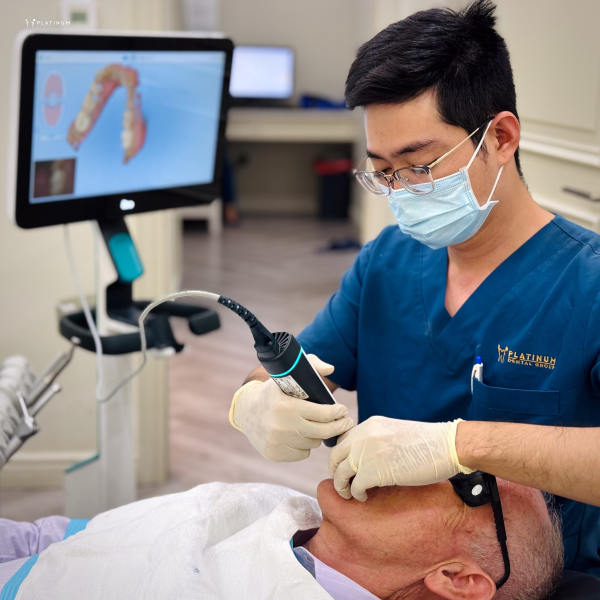
Grind teeth, attach temporary teeth, and choose color
The doctor proceeds with tooth reduction and contouring according to the precise ratio, creating enough space to seat the crown or veneer while still maximizing the preservation of the natural tooth structure. This process is performed gently and safely under local anesthesia to minimize any discomfort.
Try on porcelain teeth, discuss shape, color, and make adjustments if necessary
After fabrication, the dental restorations are tried on the natural teeth to verify the shape, size, and color. Adjustments are made by the doctor if necessary to ensure the highest degree of harmony and aesthetic excellence.
Fixed and adjusted joints
After the restorations meet all requirements, the dental crown/veneer is definitively bonded using specialized adhesive cement. The dentist simultaneously fine-tunes the bite (occlusion) to ensure the client can chew comfortably without feeling any interference.
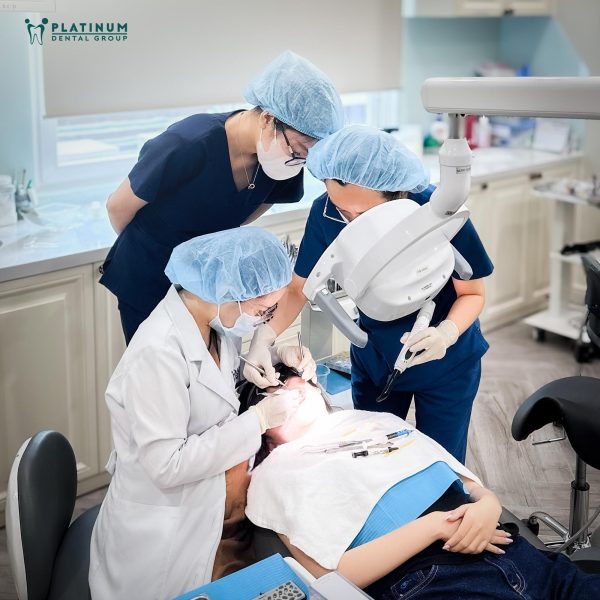
Re-examination
The client will be scheduled for a follow-up appointment to check the stability of the dental restoration, monitor the bite (occlusion), and assess the gum health. This step helps to detect any issues early on (if present) and ensures the restorative results are maintained long-term.
Read more: Are Dental Crowns Good? Should You Get Dental Crowns?
Why is it necessary to follow the porcelain teeth procedure?
Dental restoration is not merely an aesthetic enhancement; it is directly linked to long-term oral health. For this very reason, adherence to a standardized procedure is a mandatory requirement, helping to ensure safety and effectiveness for every client.
Ensure safety for real teeth and gum tissue
Procedures like tooth reduction, root canal treatment, or dental crown placement are all manipulations that affect the tooth structure. If these are not performed with the correct technique, the natural tooth can be damaged, leading to chronic sensitivity (ê buốt) or gum inflammation later on. Strict adherence to the procedure helps maximize tooth preservation and minimize potential risks.
Sustainable restoration results
An aesthetically porcelain tooth that bypasses standardized procedures is unlikely to be maintained long-term. When performed according to medical standards, the restoration will achieve optimal fit, stability, and high longevity, assuring clients can use it confidently for many years without concern for debonding or damage.
Ensuring natural aesthetics
The complete process, from taking impressions and design to the try-in of the final restorations, ensures that the shape, color, and translucency of the teeth are in harmony with the overall facial aesthetics. As a result, the porcelain teeth appear natural, not ‘fake,’ boosting confidence in your smile.
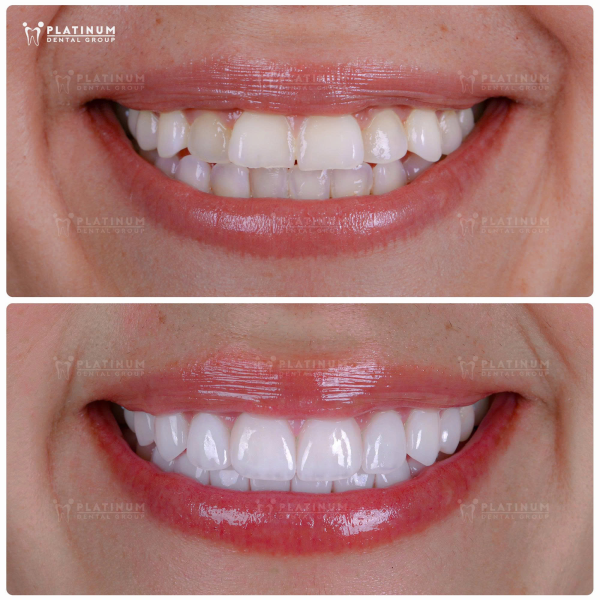
Prevent complications after restoration
If crucial steps such as diagnostic imaging (chụp phim), endodontic treatment or bite verification are overlooked, clients may face complications like pain, gum inflammation, and premature failure of the dental restoration. Adhering to the procedure helps to timely detect and manage any issues before the crowning is completed, ensuring the safest possible outcome.
The dental restoration process is not merely a ‘protocol’; it is the pivotal factor determining the quality, longevity, and safety of the final crowns/veneers. This is precisely why you should choose a reputable dental clinic with expert doctors and modern equipment for your treatment.
Platinum Dental Group – A reputable porcelain teeth address in Ho Chi Minh City
Platinum Dental Group boasts a team of highly experienced dental restoration specialists who are well-trained and consistently update their knowledge. Crucially, every client receives an individualized examination, diagnosis, and treatment plan, ensuring accurate and safe medical indication for each specific case.
Highly specialized doctors with rich practical experience
At Platinum Dental Group, the quality of treatment is under the guidance of Dr. Tran Lan Anh – co-founder and currently Head of the Dental Porcelain Cosmetic Department of the clinic. With a wealth of academic and practical experience from specialized programs in France, Canada and Spain, Dr. Tran Lan Anh not only has a firm grasp of techniques but also has a sophisticated and modern aesthetic mindset. Each treatment is performed with the utmost meticulousness, ensuring:
- Digital Smile Design according to individual facial proportions.
- Aesthetic restoration for discolored teeth, enamel wear, and minor misalignments.
- Integration of gum contouring in cases of gummy smile.
- Comprehensive reconstruction of the harmony and balance of the smile and face.

More than just a treating doctor, Dr. Tran Lan Anh directly oversees the clinical quality at Platinum. In addition, Platinum Dental Group also gathers many other specialists such as Dr. Phung Le Phuong Dung – specializing in orthodontics and cosmetic restoration, trained at Bordeaux University (France); Dr. Bui Quoc Duy, Dr. Dang My Hang, Dr. Dang Duy Phuong – rich in clinical experience, dedicated in treatment and officially certified by the Ministry of Health,… ensuring that each customer receives the highest results in terms of aesthetics, durability and long-term safety.
Modern equipment and technology
The machinery and equipment system at Platinum Dental Group is invested synchronously according to international standards, supporting the process of taking impressions, designing and making porcelain teeth accurately. Some modern equipment at Platinum Dental Group can be mentioned as: iTero 5D Scanner, CAD/CAM system for making porcelain teeth accurately, T-Scan machine for analyzing bite force, Digital smile design software (DSD)… Thanks to that, customers can experience a quick process, limit invasion and achieve optimal fit.
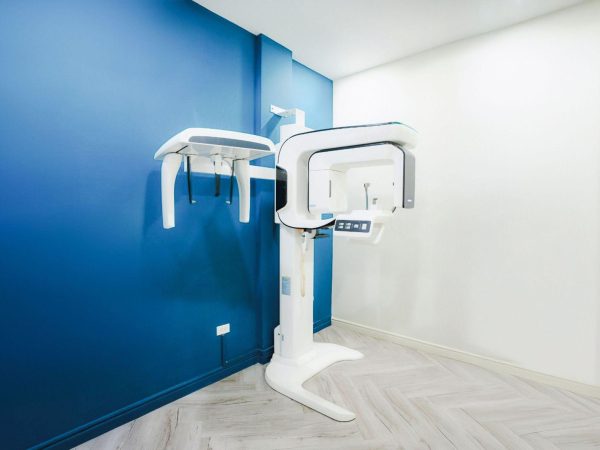
Unique, personalized, natural architectural style
Every smile carries a distinct signature. At Platinum Dental Group, our doctors do not simply restore teeth; we ‘engineer unique smiles’ based on each client’s facial features, demeanor, and personal aspirations. Through the personalized design of dental restorations, the post-treatment smile achieves harmony and a natural look, without being artificial, while fully reflecting the individual’s unique presence.
Quality porcelain materials, diverse choices
We provide many genuine porcelain teeth imported from Europe and the United States, certified for biological safety, non-irritating to the gums and extremely natural color. All types of porcelain meet standards of durability, strength and aesthetics, suitable for the needs and financial capacity of each customer, helping to maintain beauty for 10-15 years if properly cared for.
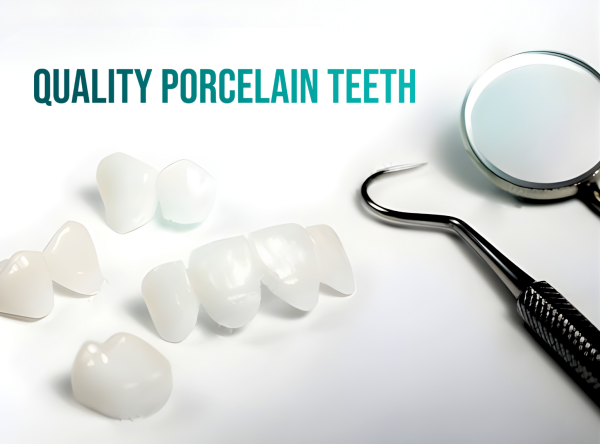
Standard process, absolutely safe
At Platinum Dental Group, every dental restoration case strictly adheres to a standardized procedure: from examination, diagnosis, and root canal treatment (if necessary) to final crown placement and periodic follow-ups. This assures clients that their natural teeth are preserved to the maximum extent, and the restorations will be beautiful and durable long-term. Furthermore, all steps in the procedure are performed with precise and gentle techniques. Clients will not experience any pain or sensitivity and can resume normal activities immediately after completion.
Dedicated post-prosthetic care
Our commitment at Platinum Dental Group extends beyond the completion of the restoration case; our team remains a long-term companion to clients throughout the post-treatment care process. You will be thoroughly guided on proper hygiene, diet, and periodic follow-up appointments to maintain a healthy and beautiful smile for many years.
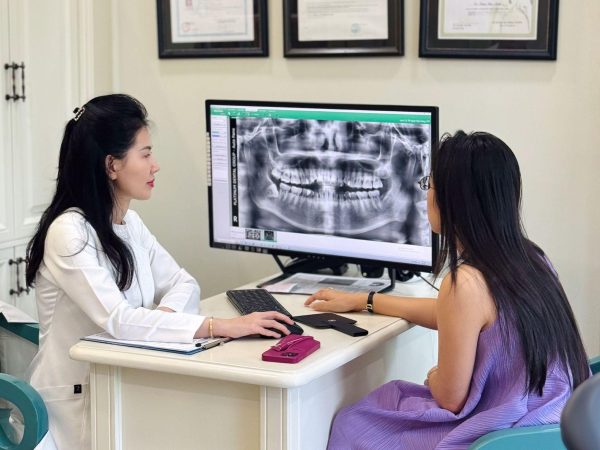
FAQ
Do porcelain crowns hurt?
The porcelain crown process is performed with the help of anesthesia, so customers hardly feel any pain during the treatment. After completion, there may be a slight feeling of soreness for the first few days, but it will quickly disappear when the tooth is stable.
How long do porcelain teeth last?
The average lifespan of porcelain teeth is 10 – 15 years, or even longer if done properly and well cared for. High quality porcelain materials combined with proper oral hygiene habits will help teeth maintain their durability and long-term aesthetics.
Does a porcelain crown damage real teeth?
If correctly indicated and performed at a reputable dental clinic, dental crowning will not damage the natural tooth. On the contrary, a dental crown helps protect weak teeth or teeth that have undergone root canal treatment, preventing further cracking or fracture. The key is for the dentist to perform minimal and proper tooth reduction while strictly adhering to the standardized procedure.
Can I eat normally after getting dental crowns?
Clients can completely resume normal eating habits once the crowns stabilize. However, to maintain durability, it is advisable to limit tearing or biting excessively hard foods and consistently maintain good oral hygiene and periodic follow-up appointments as directed by the dentist.
Do dental crowns cause black lines at the gum margin?
Black lines at the gum margin typically occur with porcelain-fused-to-metal crowns after a period of use. To avoid this, clients can choose all-ceramic crowns – a type of restoration with natural color, superior biocompatibility, which prevents black gum lines and ensures long-term aesthetics.
How long does the dental crowning process take?
The procedure usually requires 2 to 4 appointments, depending on the number of teeth to be restored and the client’s oral condition. With the support of modern technology at Platinum Dental Group, this process can be accelerated while maintaining accuracy and safety.
Porcelain teeth are a modern cosmetic and restorative solution, but are only truly safe and effective when following standardized procedures and appropriate indications for clinical conditions. Each customer has unique dental characteristics, so personalized consultation and examination are key factors to ensure natural aesthetic results and long-term durability.
At Platinum Dental Group, we are committed to providing you with a professional, safe and precise porcelain teeth process, accompanied by a team of experienced doctors and a modern technology system. If you are interested in porcelain dental services, make an appointment at Platinum Dental Group today to own a healthy, beautiful, confident and long-lasting smile.
Platinum Dental Group
Clinic Locations:
📍Platinum Dental Central: 127 Nguyen Cu Trinh Street, Cau Ong Lanh Ward, Ho Chi Minh City
📍Platinum Dental Thao Dien: 1H Street 10, An Khanh Ward, Ho Chi Minh City
📞 Hotline: (+84) 28 3920 9969 | 096 779 7799
✉️ Email: info@platinumdentalvietnam.com
🌐 Website: https://platinumdentalvietnam.com/
💬 Instagram: https://www.instagram.com/platinumdental.vietnam/
🔗 Facebook: https://www.facebook.com/platinumdentalvn



 Tiếng Việt
Tiếng Việt
